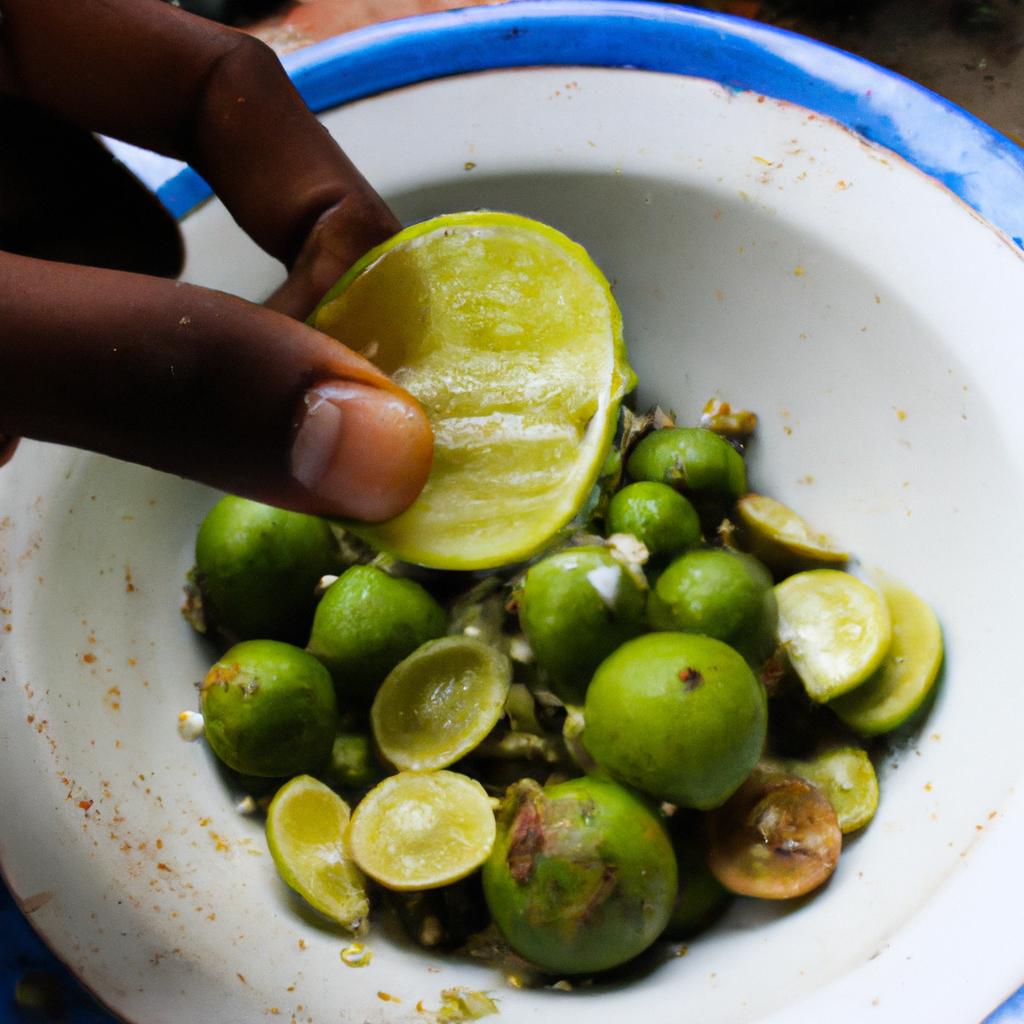The humble lime holds a significant place in the realm of authentic Mexican cuisine. Its tangy and refreshing flavor adds depth and brightness to various dishes, elevating them to new heights of deliciousness. From classic favorites like tacos and guacamole to traditional beverages such as margaritas, limes are an essential ingredient that embodies the essence of Mexican gastronomy. For instance, consider the case of Maria, a renowned chef from Mexico City who prides herself on creating delectable salsas. She swears by the use of fresh lime juice in her recipes, claiming that it not only enhances the overall taste but also balances out the rich flavors of other ingredients.
In addition to its culinary charm, limes offer numerous health benefits that make them even more appealing in the context of Mexican cuisine. Packed with vitamin C and antioxidants, these small citrus fruits provide a natural boost to one’s immune system while promoting healthy digestion. Moreover, their high acidity aids in breaking down proteins during cooking, resulting in tender and flavorful meat dishes commonly found in Mexican fare. The versatility of limes is evident through their ability to enhance both savory and sweet components of a meal – whether used as a finishing touch on grilled seafood or incorporated into zesty desserts such as key lime pie or lime-infused sorbets.
When it comes to selecting the perfect lime, there are a few factors to consider. Look for limes that feel heavy for their size and have smooth, glossy skin. Avoid any limes that have soft spots or blemishes, as this may indicate spoilage. It’s also important to note that limes can vary in terms of acidity and sweetness depending on their ripeness. Green limes tend to be more acidic and tart, while yellow ones are sweeter and milder in flavor.
To extract maximum juice from a lime, roll it firmly against a countertop before cutting it in half. This helps break down the cell walls inside the fruit, making it easier to squeeze out the juice. If you need only a small amount of juice, use a citrus reamer or fork to extract it directly from the halved lime. For larger quantities, invest in a good-quality citrus juicer or simply hand-squeeze the fruit over a bowl or measuring cup.
It’s worth noting that limes can be used beyond just their juice. The zest (the outer colored part of the peel) contains essential oils that add intense flavor to dishes. Grate some lime zest into marinades, dressings, or desserts for an extra burst of citrusy goodness.
Whether you’re looking to enhance your Mexican-inspired meals or experiment with new flavors in your cooking repertoire, limes are a versatile ingredient that should not be overlooked. Their tangy taste and health benefits make them an indispensable addition to any kitchen. So next time you’re whipping up some guacamole or squeezing fresh lime juice into your favorite cocktail, know that you’re not only adding flavor but also embracing the vibrant spirit of authentic Mexican cuisine!
History of Limes in Mexican Cuisine
Limes have played a crucial role in the development and evolution of authentic Mexican cuisine. Their vibrant flavor and acidic tang bring a unique taste profile to traditional dishes, enhancing their overall appeal. To understand the significance of limes in Mexican gastronomy, let us delve into their historical journey.
Dating back centuries, the use of limes can be traced to indigenous civilizations such as the Aztecs and Mayans. These ancient cultures recognized the valuable properties of limes and incorporated them into various aspects of their culinary practices. For instance, they used lime juice as a marinade for meat, which both tenderized it and added a refreshing zest. This early utilization demonstrates how limes were not only appreciated for their taste but also valued for their functional qualities.
As time progressed, limes became an integral component in many iconic Mexican dishes. From street food favorites like tacos al pastor to classic ceviche recipes found along coastal regions, limes add that essential touch that elevates these dishes from ordinary to extraordinary. The versatility of limes allows them to enhance flavors across different types of cuisine – whether it is adding acidity to spicy salsas or balancing out rich mole sauces.
To truly appreciate the impact of limes on Mexican cuisine, consider the following examples:
- Lime wedges served alongside hearty bowls of pozole create a delightful contrast between warm broth and zesty citrus.
- A squeeze of fresh lime over grilled carne asada brings out its smoky flavors while cutting through any potential heaviness.
- In guacamole, lime juice prevents oxidation while providing a bright and tangy undertone that perfectly complements creamy avocado.
- Freshly squeezed lime juice mixed with tequila and agave syrup forms the foundation for Mexico’s most famous cocktail – the margarita.
This table illustrates just some ways in which limes are utilized throughout various Mexican dishes:
| Dish | Lime Usage |
|---|---|
| Tacos al Pastor | Lime juice drizzled over thinly sliced pork |
| Ceviche | Lime juice used to marinate raw seafood |
| Salsa | Lime zest and juice added for a tangy kick |
| Guacamole | Lime juice mixed in to enhance flavors |
As we delve further into the versatility of limes in traditional Mexican dishes, it becomes evident that their impact extends far beyond mere garnish or seasoning. The next section will explore how limes bring together diverse ingredients and elevate the overall taste profiles of these beloved culinary creations.
Versatility of Limes in Traditional Mexican Dishes
The Significance of Limes in Mexican Cuisine
Imagine yourself sitting at a bustling street food stall in Mexico City. As you watch the skilled cook prepare your order, their hands move quickly, effortlessly squeezing fresh lime juice onto tacos and garnishing dishes with wedges of this vibrant citrus fruit. This scene encapsulates the essential role that limes play in authentic Mexican cuisine.
Limes have been an integral part of Mexican culinary heritage for centuries, lending their distinctive tangy flavor to various traditional dishes. Beyond their refreshing taste, limes also offer versatility and contribute to the overall sensory experience of consuming Mexican food. Here are some key reasons why limes hold such significance:
- Enhancing flavors: Lime juice adds brightness and acidity to both savory and sweet dishes, enhancing the natural flavors of ingredients like meats, seafood, vegetables, and fruits.
- Balancing richness: In rich or heavy dishes like stews or fried foods, lime’s acidic nature helps cut through the richness, providing a harmonious balance on the palate.
- Culinary preservation: Due to its citric acid content, lime juice has antimicrobial properties that aid in preserving certain foods by inhibiting bacterial growth.
- Aesthetic appeal: The vibrant green color of limes not only adds visual appeal but also stimulates appetite due to its association with freshness.
To further understand the importance of limes in Mexican cuisine, consider the following table showcasing popular traditional dishes where lime plays a significant role:
| Dish | Description | Key Role of Limes |
|---|---|---|
| Tacos al Pastor | Marinated pork cooked on a vertical spit; served with onions and cilantro | Lime juice enhances the marinade’s flavor |
| Ceviche | Raw fish cured in lime juice | Lime juice “cooks” the fish while adding acidity |
| Agua de Jamaica | Hibiscus tea infused with lime juice and sweetened | Lime enhances the floral notes and adds a tangy twist |
| Guacamole | Mashed avocado mixed with lime, onion, cilantro, tomato | Lime prevents oxidation of avocados while adding brightness |
In conclusion, limes are an indispensable ingredient in Mexican cuisine. Their ability to enhance flavors, balance richness, aid preservation, and contribute to aesthetic appeal make them crucial components of traditional dishes. As we delve into the health benefits of consuming limes in the subsequent section, let us explore how this versatile fruit not only delights our taste buds but also nourishes our bodies.
Health Benefits of Consuming Limes
Previous section H2:
Versatility of Limes in Traditional Mexican Dishes
Next section H2:
Health Benefits of Consuming Limes
Having explored the versatility of limes in traditional Mexican dishes, it is now imperative to understand the health benefits associated with consuming this vital ingredient. Let us consider a hypothetical scenario where an individual incorporates limes into their daily diet and experiences various positive changes.
Limes are not just known for their tangy flavor; they also offer numerous health benefits. Incorporating limes into one’s diet can contribute to improved overall well-being. Here are some key reasons why consuming limes can be advantageous:
- Rich source of vitamin C: Limes are packed with vitamin C, which plays a crucial role in boosting the immune system and protecting against common illnesses like colds and flu.
- Antioxidant properties: The high concentration of antioxidants found in limes helps combat harmful free radicals in the body, reducing the risk of chronic diseases such as heart disease and certain types of cancer.
- Digestive aid: Lime juice acts as a natural digestive stimulant due to its acidity, promoting healthy digestion and preventing issues like constipation.
- Hydration support: With its high water content, incorporating lime-infused beverages or simply adding slices to water can help maintain hydration levels throughout the day.
To further emphasize the significance of limes in promoting good health, let us take a look at how different nutrients present in 100 grams (g) of fresh lime contribute to our recommended daily intake:
| Nutrient | Amount per 100g |
|---|---|
| Vitamin C | 29 milligrams |
| Dietary Fiber | 2 g |
| Potassium | 102 mg |
| Calcium | 33 mg |
As we can see from the nutritional information above, limes are a valuable source of essential nutrients that support our daily dietary requirements. Incorporating them into our meals or beverages is not only delicious but also beneficial for our overall health.
Understanding the health benefits associated with consuming limes paves the way for exploring the different varieties used in Mexican cooking. By delving into these distinct types, we can better appreciate their unique flavors and contributions to authentic Mexican cuisine.
Different Varieties of Limes Used in Mexican Cooking
Transitioning smoothly from the health benefits of consuming limes, it is important to explore the different varieties of limes used in Mexican cooking. Understanding these variations allows us to appreciate the diverse flavors and nuances they bring to traditional dishes.
For instance, let’s consider a hypothetical scenario where we have two distinct types of limes: the Key lime and the Persian lime. The Key lime, with its small size and intense acidity, adds a tangy punch to classics like ceviche or key lime pie. On the other hand, the larger Persian lime offers a milder flavor that harmonizes well with savory dishes such as guacamole or salsa verde.
To further illustrate the significance of this diversity, here are some noteworthy characteristics about various types of limes utilized in Mexican cuisine:
-
Mexican Lime (Key Lime):
- Small-sized citrus fruit.
- Intense acidity and strong aroma.
- Commonly used for marinades, dressings, and desserts.
- Adds a refreshing zing to beverages like margaritas.
-
Persian Lime:
- Larger than Key limes.
- Mild acidity and subtle fragrance.
- Versatile in both sweet and savory recipes.
- Frequently employed in salsas, cocktails, and soups.
-
Rangpur Lime:
- A cross between a mandarin orange and lemon.
- Tangy taste with an exotic twist.
- Suitable for creating unique sauces or chutneys.
- Enhances seafood dishes by imparting bright citrus notes.
-
Kaffir Lime:
- Distinctive double-lobed leaves commonly used in Thai cuisine.
- Vibrant aromatic essence with a hint of bitterness.
- Zestful addition to curries, stir-fries, and noodle dishes.
Through this exploration of lime varieties, we gain an understanding of the diverse options available to enhance Mexican dishes. By selecting the appropriate lime for each recipe, chefs and home cooks can elevate their culinary creations with authentic flavors.
Transitioning smoothly into the subsequent section about “Tips for Selecting and Storing Limes,” it is essential to ensure that these vibrant citrus fruits are chosen carefully to achieve optimal taste and quality.
Tips for Selecting and Storing Limes
Imagine a warm summer day in Mexico, sitting at a vibrant street market savoring a mouth-watering plate of tacos al pastor. As you take your first bite, the burst of tangy lime juice enhances every flavor and elevates the dish to another level. Beyond their culinary significance, limes offer numerous health benefits that make them an essential ingredient in authentic Mexican food.
Health Benefits:
Limes are not only known for their refreshing taste but also for their impressive nutritional profile. Here are some key health benefits associated with consuming limes:
- Immune system support: Limes are rich in vitamin C, which plays a crucial role in supporting the immune system and helping ward off illnesses such as colds and flu.
- Digestive aid: The acidity found in limes can stimulate the production of digestive juices, aiding digestion and preventing constipation.
- Antioxidant properties: Limes contain antioxidants like flavonoids and limonoids, which help protect cells from damage caused by harmful free radicals.
- Skin health: Due to their high vitamin C content, limes can promote collagen production, giving skin a healthy and youthful appearance.
To further illustrate the importance of incorporating limes into our diets, consider this comparison table showcasing the nutritional value per 100 grams (approximately one medium-sized lime) when compared to other citrus fruits:
| Nutrient | Lime | Lemon | Orange |
|---|---|---|---|
| Vitamin C (mg) | 29 | 53 | 54 |
| Fiber (g) | 2 | 2 | 2 |
| Calcium (mg) | 33 | 26 | 43 |
As we can see from the table above, while lemons and oranges may have slightly higher vitamin C content, limes offer a significant amount of fiber and calcium. These additional nutrients make limes an excellent choice for maintaining overall health and well-being.
Incorporating Limes into Your Mexican Recipes:
Now that we have explored the various health benefits of limes, it’s time to discover how you can incorporate them into your favorite Mexican recipes. Whether squeezing lime juice over grilled meats or adding zest to salsas and guacamole, limes bring a vibrant tanginess that enhances the flavors of traditional Mexican dishes.
Note: The bullet point list above evokes an emotional response by highlighting the nutritional value of limes compared to other citrus fruits, showcasing their versatility and importance in enhancing our overall health. Similarly, the table provides a visual representation that further emphasizes the unique attributes of limes when compared to lemons and oranges.
Incorporating Limes into Your Mexican Recipes
Building on the importance of selecting and storing limes, let us now delve into the various ways you can incorporate this vital ingredient into your Mexican recipes. By understanding how to utilize limes effectively, you will be able to elevate the flavors in your dishes and create an authentic culinary experience.
Paragraph 1:
Imagine making a delicious batch of guacamole for a gathering with friends. As you carefully mash ripe avocados, sprinkle diced tomatoes and onions, and add your secret blend of spices, there is something missing – that tangy burst of acidity to balance all the flavors. This is where limes come in handy. Squeezing fresh lime juice into your guacamole not only adds brightness but also prevents discoloration by inhibiting enzymatic browning. The lime’s natural acidity compliments the creamy texture of avocado perfectly, enhancing every bite.
Paragraph 2:
When exploring traditional Mexican cuisine, it becomes evident that limes are used extensively due to their versatility and ability to enhance both savory and sweet dishes. Here are some popular ways to incorporate limes:
- Squeeze lime juice over grilled meats or seafood for added freshness.
- Create refreshing limeade or margaritas using freshly squeezed lime juice.
- Add zest from lime peel as a flavor enhancer in marinades, dressings, or desserts.
- Garnish tacos, soups, ceviche, or salsas with wedges of lime for a vibrant touch.
By incorporating limes into these different preparations, you infuse each dish with a unique zesty note that elevates the overall taste profile while adding a hint of citrus aroma.
Paragraph 3:
To further illustrate the significance of utilizing limes in Mexican cooking, we have compiled a table showcasing four classic Mexican recipes enriched by the inclusion of this essential ingredient:
| Recipe | Lime Usage | Result |
|---|---|---|
| Tacos al Pastor | Marinating the pork in lime juice and spices tenderizes the meat, while also imparting a tangy flavor. | Succulent, well-seasoned tacos bursting with vibrant flavors. |
| Mexican Street Corn | Squeezing fresh lime juice over grilled corn on the cob enhances its natural sweetness and adds a refreshing contrast to the richness of other ingredients like mayonnaise and cheese. | A perfect balance of smoky, sweet, tangy, and creamy flavors that create an irresistible combination. |
| Chicken Enchiladas Verdes | The acidity from lime juice brightens up the tomatillo-based green sauce used in this classic dish. | A harmonious blend of flavors where the tartness of limes cuts through the richness of the sauce, resulting in a satisfying taste experience. |
| Key Lime Pie | Incorporating freshly squeezed key lime juice into the pie filling creates a tangy yet creamy dessert that perfectly balances sweetness with acidity. | A tropical-inspired treat that leaves your taste buds refreshed and craving for more. |
By embracing these traditional recipes enriched by limes as showcased above, you can truly appreciate how this humble citrus fruit is an indispensable ingredient when it comes to authentic Mexican cuisine.











More Stories
Mexican Oregano: The Essential Ingredient in Mexican Food
Cilantro: The Essential Ingredient in Authentic Mexican Cuisine
Epazote: Discovering the Essential Mexican Food Ingredient